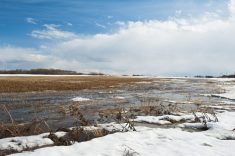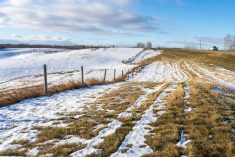Winnipeg | Reuters –– Floods that washed across Saskatchewan and Manitoba last weekend hit farmers twice, drowning newly seeded fields of wheat and canola, while also ruining stockpiles of last year’s crops.
Heavy rain of up to 260 millimetres (10.2 inches) swamped the eastern side of Western Canada’s crop belt last weekend, submerging crops, washing out roads and forcing hundreds of people to leave their homes.
Jody Kachur, who farms near Wishart, Sask., said the “disastrous” rains flooded bins containing canola and oats that he harvested last year, and likely ruined the crops. About 1,500 acres of recently planted canola, oats, barley and wheat were underwater.
Read Also

Feed Grain Weekly: Prices starting to pick up
Prices for feed grain are “grinding higher” said Evan Peterson, trader with JGL Commodities in Saskatoon.
“What do you do? No one here has seen this much water, ever,” he said.
A record Prairie harvest last year backed up railways that move crops to port during the winter, forcing farmers to keep more of their crops in storage than usual.
Kachur said he will salvage what he can, and hopes to collect provincial crop insurance. He is not alone.
“It’s like a lake in certain parts of Saskatchewan and Manitoba,” said Wayne Palmer, senior analyst at AgriTrend, a consulting firm for farmers. He knows of other farmers who have lost both growing crops and stored supplies that sat too long in water.
Depending on the crop, plants can survive two to three days under water. But young plants have not expanded their root systems widely enough to find oxygen in the soil.
A large portion of eastern Saskatchewan and western Manitoba received record amounts of precipitation from April 1 through Thursday, according to the federal agriculture department.
Agriculture analysts have crunched widely varying estimates of how much of the growing crop was destroyed in the flood, with some saying no one will know for sure until the water recedes.
Brenda Tjaden Lepp, chief analyst at FarmLink Marketing Solutions, estimated the floods ruined one million acres of crops, representing just over one per cent of the Canadian area, and possibly many more.
The rain may have killed six million acres of crops across Manitoba, Saskatchewan and Alberta, with about 4.4 million of those in Saskatchewan, said analyst Larry Weber of Weber Commodities. Another 2.1 million acres weren’t planted at all due to bad weather, he said.
Futures markets have not registered much alarm yet even though Canada is one of the world’s biggest wheat exporters and the world’s largest canola exporter. ICE Canada November canola futures were trading lower for the week.
Those crops that have survived are struggling. More than half of spring cereal crops and two thirds of oilseeds are behind their normal development in Saskatchewan, the provincial government said on Thursday.
Flood water has started to recede in Saskatchewan and is flowing into Manitoba. Environment Canada’s seven-day forecast calls for mostly hot, dry weather over the next week.
— Rod Nickel is a Reuters correspondent based in Winnipeg.















